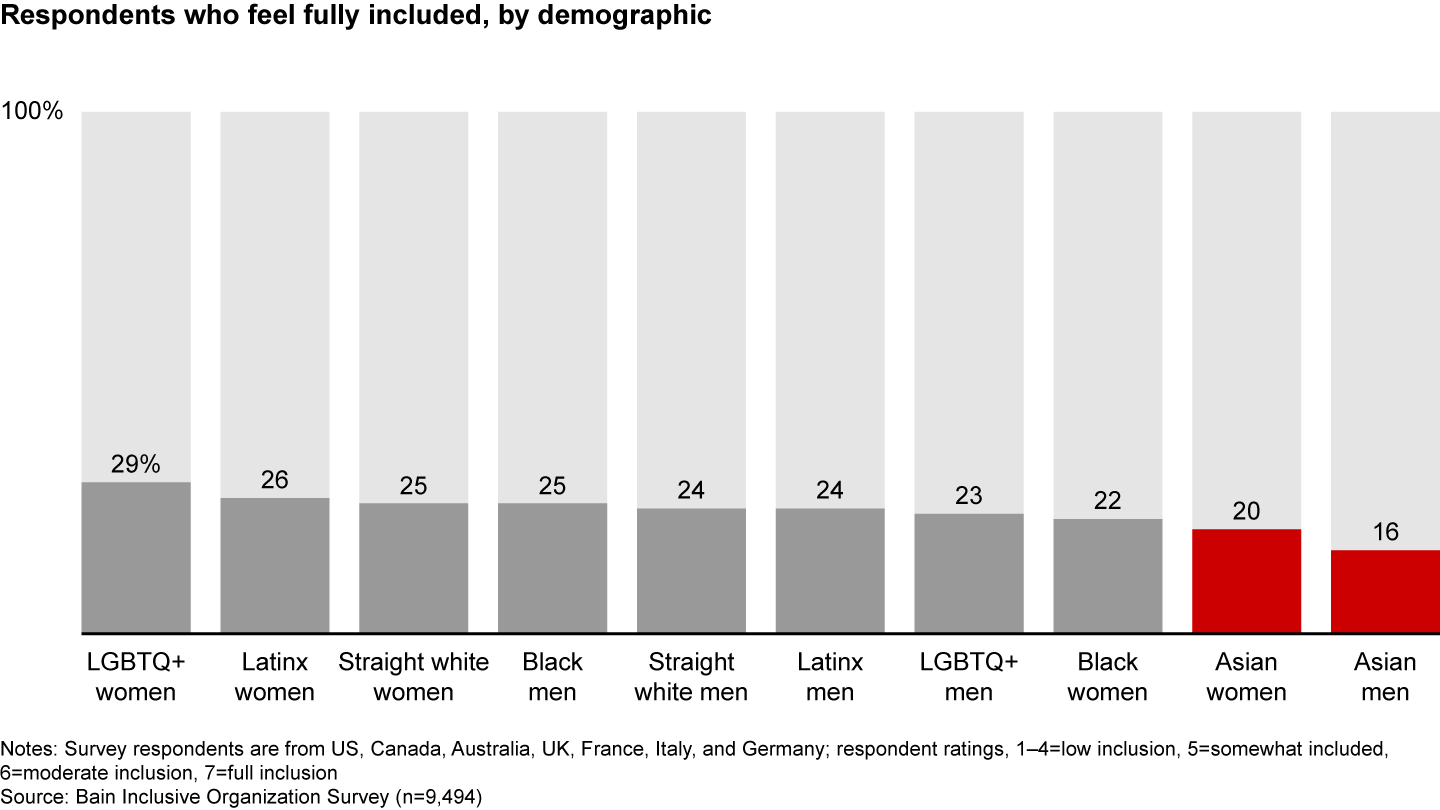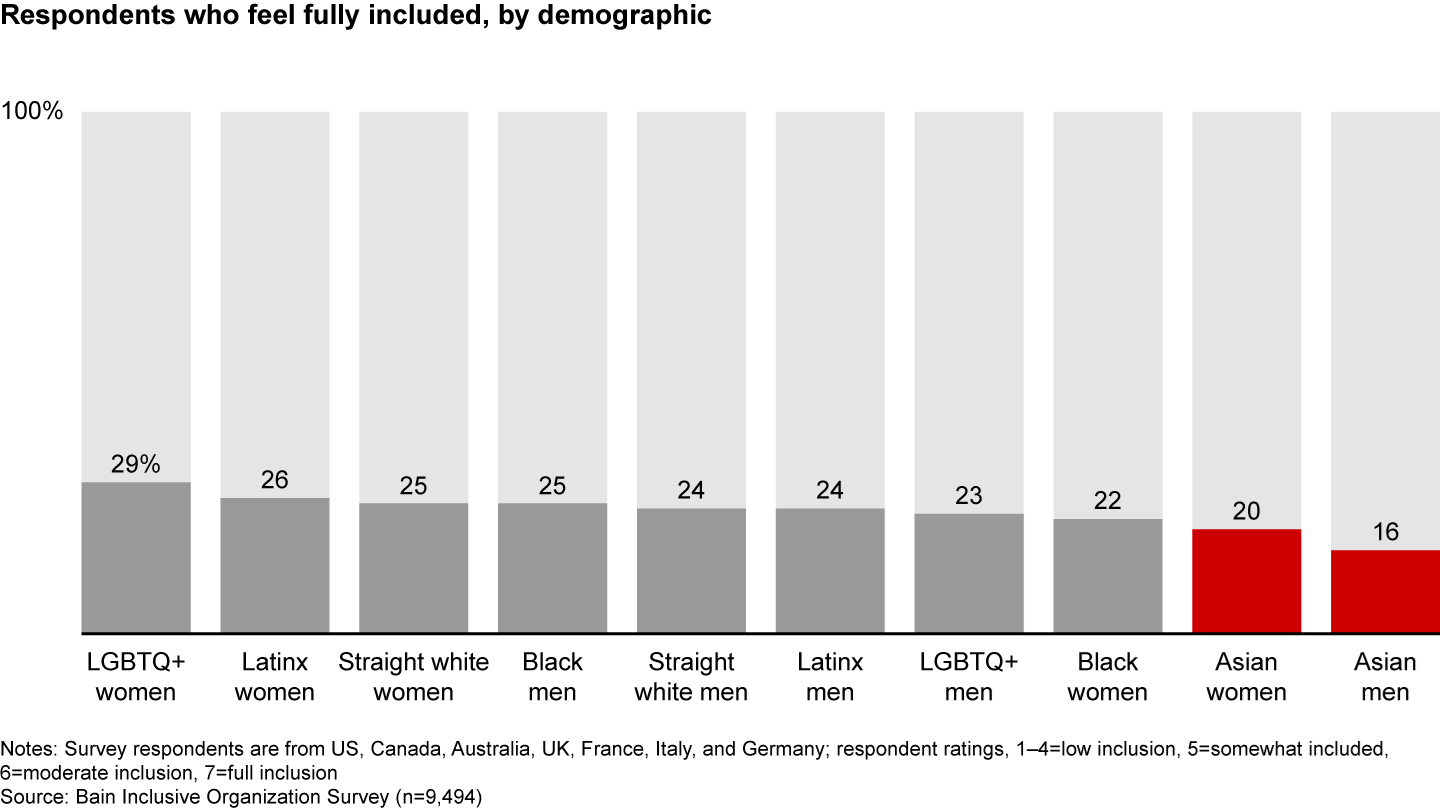Brief

This Asian American Heritage Month, it feels more important than ever for those of us in the Asian American and Pacific Islander (AAPI) community in the US to celebrate our diverse heritages and share our individual and collective stories. The past several years (and the last year in particular) have been incredibly challenging for our community. The Atlanta spa shooting in March 2021 is just one example of a wave of anti-Asian violence that has brought into sharp focus the day-to-day risk of interpersonal racism, particularly for our most vulnerable community members, and it triggered reflections on the broader institutional racism affecting AAPI populations.
As leaders with our Asians at Bain community as well as with Bain’s Diversity, Equity & Inclusion practice, the two of us want to take some time to reflect on the experiences of Asian Americans in the workplace, where the persistence of discrimination, microaggressions, and the “bamboo ceiling” (though not rising to the level of physical violence) continues to take a toll. Bain research for our article “The Fabric of Belonging” found that only 25% to 30% of employees across all geographies, industries, and demographic groups say that they feel fully included at work, which is a depressing statistic on its own. Among all demographic groups, however, Asians reported feeling the least included, with only 16% of Asian men and 20% of Asian women saying they felt fully included at work (see Figure 1). These percentages are significantly lower than that for the third-lowest group, Black women, at 22%.
Asian men and women feel the least included of all the demographic groups Bain surveyed


In this context, it is hard not to view Asian experience in the workplace in a new light. Asian Americans overall are well educated and do well economically relative to the US population as a whole. Such achievements are to be celebrated. Yet looking only at such broad measures of success obfuscates the complexity of the AAPI experience.
Asians still face significant barriers in the workplace. In particular, Asians experience the effects of a bamboo ceiling in advancing to leadership roles. While 9% of the professional workforce in the US identifies as Asian, only 2% of CEOs do. Such leadership underrepresentation is the norm across industries, even in the tech sector: In Silicon Valley, Asian Americans comprise the largest cohort (47%) of entry-level, nonmanagerial employees with a college degree or higher (“professionals”), but they are only half as likely as white men and white women to hold positions within two reporting levels of the CEO (“executives”). And Bain is no different, with a large representation gap between its junior and leadership levels.
Why do Asians experience these outcomes?
To begin with, we must acknowledge that the Asian community in the US is very diverse, so there isn’t even one Asian American identity or experience. Not only are there a multitude of ethnicities among Asian Americans, but there are also stark differences in lived experiences, socioeconomic statuses, and cultural dissonance, depending on where an Asian family lives and how long they have been in the US.
One characteristic of Asian Americans across the board is that, in one way or another, we struggle with the challenges of acceptance and assimilation. The exact nature of the challenge varies by generation. First-generation immigrants often struggle the most, simply from culture shock. Second- and later-generation immigrants, with different life and work experiences than their parents had, often must deal with confusion, great pressure to assimilate to Western cultural norms that can be at odds with familial ones, and a feeling of being a perpetual foreigner in spite of being American by birth and citizenship. (The two of us both have felt that at times, perhaps more so in recent years, in spite of having grown up in the US.)
Stereotypes also play a role in shaping the workplace experiences of Asian Americans. One version of the “model minority” myth “characterizes Asian Americans as a polite, law-abiding group who have achieved a higher level of success than the general immigrant population through some combination of innate talent and pull-yourselves-up-by-your-bootstraps immigrant striving.” Unfortunately, this myth erases the different experiences across the community, and it belies the racism and other barriers we experience. And in internal focus groups that we have conducted at Bain, our Asian leaders have cited a lack of role models as well as stereotypes and cultural norms, making it more challenging to advocate for themselves as additional hurdles in the way of professional advancement.
As we reflect on these experiences, we know our community will continue to face challenges. Those of us belonging to an older generation of Asian American professionals—the two of us are second- and third-generation immigrants, respectively—have striven to assimilate into white American society, but at what cost? We have stayed silent while others use terms in the business lexicon such as “Chinese fire drill” or “Chinese menu of options,” or we have failed to properly celebrate a holiday such as Diwali by taking the day off from work and spending it with family. We believe that our junior colleagues are going to insist on being able to bring more of their cultures and experiences to the workplace than we did so that they can feel as though they belong as their authentic selves, and we need to do our part to make that possible for them.
We believe that our junior colleagues are going to insist on being able to bring more of their cultures and experiences to the workplace, and we need to do our part to make that possible for them.
In thinking about how to address these challenges, we draw upon our understanding that the fabric of belonging has a different texture for every community within an organization. For example, we know that people’s experiences of inclusion are grounded in both underlying systemic support (through fair processes and systems) and everyday behaviors. (We refer to these different ways of creating inclusion as systemic and behavioral enablers.) We also know that building equitable systems has more impact on feelings of inclusion for Asian employees than, for example, for white employees. Actively accounting for cultural differences in systems such as performance management, promotion, or recruitment will therefore be especially useful in creating a more equitable and inclusive environment for Asian Americans.
The facts on the ground, as opposed to widespread assumptions and stereotypes, demonstrate clearly that US companies need to start paying attention to inclusion and belonging for Asian American employees—our own organization included. As leaders at Bain, we are working to improve both the systemic and behavioral enablers of inclusion here. We have the ability to create fairer processes and systems and to embed more inclusive practices within our organization, and we must do so.
And as Asian leaders who have made it, we need to do more to help other Asians advance. We need to become more vocal leaders and coaches, to share our experiences instead of being quiet about them, to elevate the voices of people who might feel less included, and to make it possible for junior folks to believe that there is more than one model for success. We have a lot of work to do, but we are committed to making the workplace more inclusive, both within Bain and externally within our clients. Because making the workplace more truly inclusive is perhaps the most important legacy we can leave for the next generation of Asian Americans, and for Bain itself.